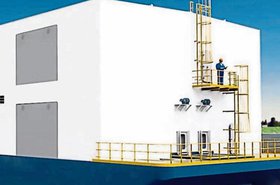Public utilities, by definition, are the ‘supply of goods or services that are an everyday necessity to the public at large’. Water, electricity, natural gas, and telephone services are among those deemed essential to our daily lives, but what about the internet?
In 2016, the UN General Assembly passed a non-binding Resolution declaring internet access a human right, yet more than one-third of the world’s population (almost three billion people) have never used it, and that’s something we as an industry need to change.
“Access to digital infrastructure is now as essential as any other infrastructure for most of humanity,” says Jim Connaughton, CEO at Nautilus Data Technologies.
Unfortunately, even when it’s for the greater good, inherently, human beings don’t like change, which can make placing data centers into communities – which are required for internet access – somewhat challenging.
This is amplified that despite recent efforts for change, data centers have gained a reputation for being noisy, unsightly, power-hungry, water-guzzling behemoths that left unchecked, become part of the overall pollution problem and detriment to the planet.
In years gone by, this might have been the case, but what if these communities knew the addition of a data center, if run via sustainable best practice and with the correct (carefully considered) placement, could result in environmental, as well as economic betterment, rather than a pre-conceived detriment?
“Since this is a fundamental utility infrastructure that’s being built out, it’s important to think about building it in tandem with other new infrastructure, thinking about future renewable electricity, and the extra water treatment that’s going to be needed,” says Arman Shehabi, research scientist at Lawrence Berkley National Laboratory.
He continues, “As they’re being put into different communities, we need to be thinking how data centers can come in and actually make the electricity and water in that area cleaner.”
A gigaton scale opportunity
Data centers are in fact one of the most important new engines for sustainability. They are the plumbing that undergirds smart cities, smart transportation, smart grids, telemedicine, and remote education; essentially, they underpin the world’s digital future.
Of course, to achieve this, as well as hitting the rather ambitious net-zero by 2050 target, data centers themselves need to be as sustainable as possible.
“If you look at any of the growth rates for data processing and storage against the total energy consumption of data centers, the combination of computing improvements, plus infrastructure improvements alone can afford more than a gigaton of carbon avoided, which is what we're going to need if we want to get to net zero. So, there's a gigaton opportunity there, just in the data center infrastructure combined with advanced computing,” says Connaughton.
But what about water?
Air pollution, water scarcity, and power demands are major concerns when it comes to data centers and community pushback, particularly in the developing world. But as data centers advance into emerging markets, they should not be creating an environmental burden in the form of air pollution, nor should they be creating competition within a community for drinking water supply or wastewater services.
“As an analyst, one of the challenges is always trying to understand, ‘What’s the growth of data centers? How much electricity are they using?’ It’s a fairly secretive industry overall, it’s not that transparent,” says Shehabi.
He continues, “Being more transparent with the community, so that community understands what’s going to be the electrical power demand, what’s going to be the water draw and how that data center is going to be affecting the community. Working with the community coming in so that people are aware of what’s going to happen I think would help a lot.”
And it’s worth noting that not all data centers are created equal, nor are they managed equally. Historically, corporate action, particularly among data centers and water usage has been far less publicly visible than strategies for reducing energy usage and GHG emissions for example.
But, as of 2020, according to the CDP, around two-thirds of reporting businesses are reducing their water withdrawals; slightly more than half are monitoring the quality of their wastewater discharges and just four percent are making progress against water pollution targets.
As time has gone on, several high-profile multinationals have become markedly more vocal about their intentions. Google has recently pledged to replenish 120 percent of the water it uses by 2030, as well as “identifying opportunities to use freshwater alternatives where possible at its data centers”, according to Kate Brandt, Google’s chief sustainability officer.
Facebook has also acknowledged concerns over water consumption in the data center, countering this with three water restoration projects that together, it claims “will restore over 200 million gallons of water per year in the Colorado River and Salt River basins and will help provide greater water security for the entire state."
But all these companies are still consuming water. Nautilus Data Technologies has taken it one step further, consuming no water at all with its commissioned data center in California. The Stockton facility utilizes a liquid heat sink in a closed system of pumps and pipes and consequently runs silent. Nor does it handle any chemicals on site. In fact, the data center sits just 200 yards away from a very large residential community, with most of the residents none the wiser.
“When you water cool, you can be right next to a residential community, but if you’re building conventionally, you’re increasingly an eyesore and a nuisance,” says Connaughton.
“Some data centers currently being constructed are noisy, and they use a lot of refrigerants that are potent greenhouse gases, and ozone-depleting substances. So you have this footprint that comes with putting a data center into new communities.
“Technology now exists, that can more affordably get rid of that entire footprint. Like anything else in society, once you've got a more affordable alternative, that's environmentally a lot better and can support a higher level of performance, you should be moving to it.”
Of course, when that alternative becomes more expensive, that’s when you run into problems.
“The beauty of what Nautilus has done, is we’re able to provide such an alternative at either the same or better economics, which creates a real opportunity on the social side,” says Connaughton.
Quashing competition
Right now, a lot of data centers largely compete with commercial real estate or intrude upon residential areas. Nautilus has adopted an approach that mitigates this competition and disruption to the benefit of the user, suggesting that facilities move to the ‘working’ side of town, meaning the network is not only more proximate to the user, but consequently more accessible.
Traditionally, it was the proximity to a digital provider, or locations within commercial or residential districts that were the first considerations when selecting a data center location. But this approach isn’t necessarily serving the data centers of today or the communities in which they’re being placed. New data centers consume far more electricity and require far more elaborate cooling systems than ever before, so is this approach still viable today?
“You want to be moving to where infrastructure is better supported, which is on the industrial side of town. The rent in the property is cheaper, the job opportunity for folks is greater, it’s more affordable and the competition with local communities for resources is diminished,” says Connaughton.
Due to their size and scale today, it is now far more appropriate to redevelop brownfield sites, or move across to newly emerging, working areas of town where power plants, water treatment plants and other industrial processes already exist.
This more resilient industrial geography provides users with the network access they need, they’re not having to compete with the likes of commercial real-estate for resources, and it’s closer to where they are too.
From an environmental standpoint, the data center itself can also have a far greater impact, with the ability to integrate harmoniously with other pre-existing infrastructure, as well as the scope to support and grow alongside new infrastructure in the future.
For example, the only by-product of Nautilus’ Stockton facility is slightly warmer water, but that water can be repurposed to:
- Lower the cost of desalinization of water treatment
- Lower the cost of ordinary water treatment
- Help support combined heat and power
- Assist with thermal processes by industry, such as greenhouses and aquaculture.
But as stated earlier, not all data centers are created equal, so as an industry, where do we go from here?
“We're currently doing a study trying to look at like how data centers and ICT infrastructure in general can be built out in a way in the US that can be paired with some of the US communities that are really been hollowed out from sort of exporting of manufacturing offshore.
“And there's really an opportunity here to revitalize some of these areas where there's manufacturing infrastructure, that's there, but the jobs went away, and to bring in this next generation of technology,” says Shehabi.
Overall, data centers have the ability to improve people’s lives both environmentally and economically. But for this to be realized, communication and transparency within communities are key, as well the willingness to embrace new technologies, alongside new people.
Ultimately, what we do next as an industry, and as individuals, will not only help to shape but catalyze our shift to a sustainable digital future at scale.
More from Nautilus Data Technologies
-

Sponsored Natural refrigerants: The next level of sustainability?
Data centers receive a lot of scrutiny for their water usage. Could natural refrigerants help ease the pressure?
-

Nautilus floating data center finally set to float in Limerick dock
After Covid delays, Nautilus is ready to build
-

Is focusing on carbon and PUE limiting transparency?
And how can we work around this?

